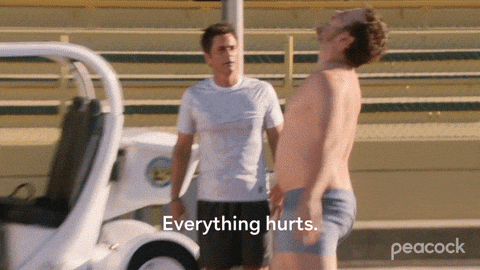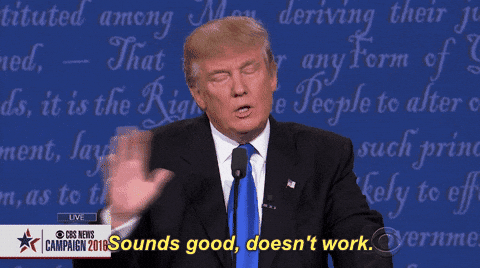I was solving the wrong problem
Marketing wasn’t failing. My thinking was.
“The clickthrough rate on our video campaign is lower than our static image campaign. Let’s kill off the video campaign as it’s not working.”
”I’m not seeing any demo requests come in from the post I just shared on LinkedIn. That’s clearly not working for us, so we won’t do it anymore.”
I could spend an hour writing out more scenarios like these that I’ve either experienced firsthand or heard from other marketers and organizations. I’m sure you’ve heard these or experienced them as well.
It’s frustrating when the numbers don’t add up. I tried a new channel or campaign or medium, and it just didn’t drive the results I was after. My instinct was to pull the plug, especially when under the constant pressure to show quick wins.
But a few years back I got curious. Why was video performing so much worse than static images in paid social? So I went a level deeper and started to break the campaigns down by the channel, audience, spend, messaging, and so forth. Still couldn’t find anything.
So I went another level deeper. What was the goal? How was I measuring this? And it hit me square in the face. I was measuring the video campaign as if it were a static image campaign.
For a video ad, you consume the content by watching the video in-feed. For a static single-image ad, you consume the content by clicking on the ad to view the content that lives on a landing page.
Here are the keywords to hone in on: “watching” and “clicking”.
Are you now starting to see the problem with the initial way we were measuring the campaign results?
The metrics I was looking at were CLICKthrough rate (CTR) and cost-per-CLICK (CPC). In order to see higher success with these metrics, they revolved around the user clicking as the sole means of consuming the content.
So that campaign that we said was consumed by watching, not clicking? Yeah, measuring success based on clicks now makes zero sense.
And this spurred me along on my journey to start to think about where I should be going multiple levels deeper to really understand what was and wasn’t working.
Sponsor: You/Your Company?
If you’re looking to get in front of an engaged audience of some of the savviest marketers + GTM practitioners, this is your opportunity. One opening per month to sponsor this newsletter has become available and I’m sure will claimed quick, so if the audience reading this newsletter is your ICP, this is your chance.
Just last week I was talking to a VP of Marketing and they said they were exploring and in negotiations with one of the sponsors of this newsletter after learning about them here + seeing them as a product that I endorse. That’s the power of these types of partnerships done well (vs. the AI influencer dumpster fire some are experimenting with).
Simply reply back to this email if you/your company is interested or drop me a DM on LinkedIn.
“Running doesn’t work for me”
Let’s start with an anecdotal story about running.
For anyone who’s seen my Friday Health Thoughts series on LinkedIn, you’ll know that running and I have an “it’s complicated” relationship. Growing up playing soccer, running was always used as a form of punishment.
Lost a game? We need to get in better shape - go run 5 miles.
Got an unnecessary card in the game? 10 sprints next practice.
As a result, soccer kept me in great cardio shape. But after winding down my soccer career post-college, the only time you’d catch me running would be playing drop-in soccer on the weekend. Zero chance I was going to choose to go for a run during my free time.
I was able to get by in my early 20s with this mindset. Youth was still on my side. But as I started to hit my late 20s and early 30s, I’d find myself starting to get winded in the gym doing basic exercises. I’d see my WHOOP stats getting worse as my resting heart rate was steadily increasing over time. That I wasn’t able to keep up in the drop-in soccer games and it was frustrating the hell out of me because I knew what I was capable of based on how I performed in years past.
And I knew exactly what I needed to do to fix all of this. I needed to work on my cardio. No ground-breaking insight here, just a realization that I had been avoiding for a few years.
So I started to incorporate running back into my life. Surely it’d get me back on track and the areas I’d noticed I was struggling with before would resolve themselves.
But they didn’t.
Running “wasn’t working” for me…or so I thought.
Binary vs. spectrum thinking
I was making the classic mistake of thinking of running in binary terms. It either worked or it didn’t work.
But when I wanted to figure out why it wasn’t working for me, I realized that it wasn’t binary at all, but that there a number of factors that went into the (lack of) progress I was making. That it was a multivariate equation. And that each variable operated on its own spectrum.
So let’s walk down the path together that I followed while trying to figure out what was going on.
Surface level
Did I run this week? Yes.
Is my cardio improving? No.
Conclusion: Running isn’t working.
Variable 1
Did I run this week? Yes.
How many times did I run this week? Once.
Is my cardio improving? No.
Conclusion: Let’s see what happens when I run 2-3 times per week.
Variable 2
Did I run this week? Yes.
How long did I run for? 20 minutes.
Is my cardio improving? No.
Conclusion: Let’s try running for 30 minutes each session.
Variable 3
Did I run this week? Yes.
What speed was I running at? 10 minute/mile
Is my cardio improving? No.
Conclusion: Let’s try running at a 9 minute/mile pace instead
Takeaway
Who would’ve thought, but running did work, I just wasn’t putting in the work required for it to be successful - I was giving up too early.
A few months at it, and I’d found the formula that worked best for me to see results.
Frequency: 3x/week
Duration: 25 minutes
Intensity: 8 minute/mile or fartlek (interval) method
Now that you have this story in mind, let’s bring this back around to marketing…
[Channel] isn’t working for me
Like I mentioned at the beginning of this newsletter, I’ve written off channels before as not working for us. But after going through the example above about running, I’ve learned to go deeper in answering multiple questions before ruling out a channel (or anything for that matter) as “not working.”
Many of you reading this are B2B marketers, so I’ll use an example of a channel that many of us are familiar with: LinkedIn Ads.
This channel is beloved by many B2B marketers due to its targeting capabilities. We can hone in on our exact buyers by having access to be able to target individuals by the type of company they work at, their job title, the size of their company, their location, the skills they possess, and countless other criteria.
Despite having all of these options at our fingertips, while working at Refine Labs, we’d have prospects and customers coming to us saying “LinkedIn doesn’t work for us.”
They were making the same type of statement I did about running. So I’d say, “Great! Let’s figure this out together.”
And this is where I was able to get the number of reps required to understand how to unpack this type of scenario and get to a way to understand if something truly didn’t work, or if it was simply a matter of reworking the variables. So let’s use the same framework as earlier and go through this together.
Surface level
Did we leverage LinkedIn this week? Yes.
Are our business results improving? No.
Conclusion: LinkedIn isn’t working.
Variable 1
Did we leverage LinkedIn this week? Yes.
How many mediums did we use? One
Are our business results improving? No.
Conclusion: Let’s see what happens when if we go beyond static images and also try out mediums such as video, carousels, thought leader ads, and sponsored inMails.
Variable 2
Did we leverage LinkedIn this week? Yes.
How long have we been running ads for? 2 weeks.
Are our business results improving? No.
Conclusion: Let’s continue running our ads for longer. The 95:5 rule tells us that at any given time, only 5% of our market is actively evaluating and 95% isn’t, so we need to give this more time to convert those who do come to market.
Variable 3
Did we leverage LinkedIn this week? Yes.
What budget were we applying? $25/day
Are our business results improving? No.
Conclusion: Let’s increase our spend to $50/day. Our budget was running out only a few hours into the working day.
Takeaway
Who would’ve thought, but LinkedIn Ads did work, the companies we worked with simply needed to better understand all of the variables at play and how to come up with their unique multivariate equation to see successful results.
This example is a simplified version in keeping to 3 variables, so here’s a non-exhaustive list of additional variables that I think about when going through this type of exercise:
Mediums (static ads, video, carousels, etc.)
Duration (how long we’ve been advertising for, in total)
Budget (how much are we spending daily/weekly/monthly/etc.)
Targeting (job titles, industries, locations, company sizes, etc.)
Messaging (product-focused, problem-focused, outcome-focused, etc.)
Offer (educate, enable, entertain, direct-response, etc.)
Visual/design (UI shots, animations, pop culture references, text-heavy, etc.)
Content (how-to, case studies, listicles, testimonials, etc.)
Conclusion
Binary thinking is a cognitive bias. We seek to simplify things as much as possible in order to determine if something does/doesn’t work, is good/bad, is right/wrong, etc. And while I am a huge advocate for being a simplifier vs. a complicator in following the maxim “be brief, be brilliant, be gone,” I realized that I can’t get to simplification without first truly understanding everything that feeds into that decision-making framework.
This is what true knowledge is. This is the type of work that is required while on the path to mastery. These are the experiences that you need to live firsthand vs. reading in a textbook in order to understand how they operate in the real world.
Book quote of the week
“There was so much I needed to learn that could only be learned by doing.”
- Education of a Wandering Man, by Louis L’Amour
In case you missed these this week
See you next Saturday,
Sam
P.S. What’s the best/your favorite AI prompt that you’ve been using lately? Doesn’t have to be work-related. Looking to incorporate this more into my day-to-day and curious to hear from others.
P.P.S. Getting a new pair of running shoes is a cheat code. 1) I didn’t understand the value of using proper running shoes until a few months ago - night and day difference and 2) They were like getting a new toy as a kid, I couldn’t wait to use them again.







Such great thinking on how to decode “X is not working for us”